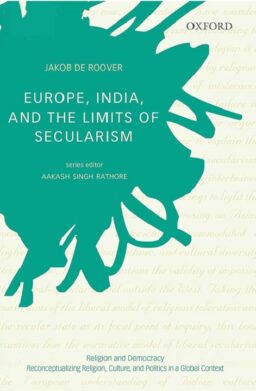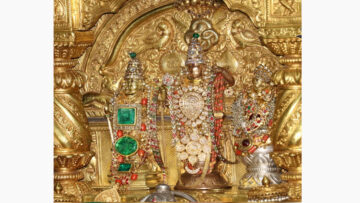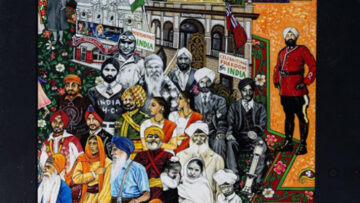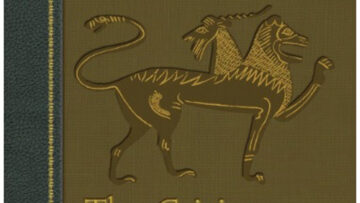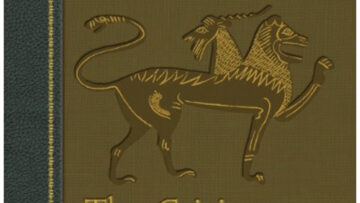….Continued from Part I
The Rise of Hindu Nationalism
Thus, the colonial policy of toleration compelled Hindu subjects to defend their practices using scriptural sanctions. The Hindus were forced to incorporate certain attitudes and features into their traditions that were derived from the Biblical model of religion. It triggered the rise of both Hindu reform movements and orthodox Hindu revivalism movements. The most well renowned of the Hindu reform movements was the Arya Samaj founded by Swami Dayanand Saraswathi. Dayanand began remodelling Hinduism along the same lines as the Biblical religion. He regarded the Vedas and Sastras as the holy scriptures of Hinduism, infallible by their very nature. Dayanand described these texts as revealing a monotheistic Hinduism, while rejecting all other texts and most of the Indian traditions as idolatry or corruption of the pure monotheistic Hinduism by Brahmin priests. From the above description of the Arya Samaj movement, it is clear that Dayanand Saraswathi is reproducing the Protestant theological tropes that the British had been using to describe the Hindu traditions for centuries. In response to the Hindu reform movements, traditional Hindu mahasabhas began to defend traditional Hindu practices as being sanctioned by the very same Vedas and Sastras which they described as the scriptures of the Hindu religion. One can see that even though they were rivals, both the Hindu reformers and traditionalists accepted the same basic model of Hinduism: as a set of practices founded on religious doctrines and scriptures.
Two important consequences emerged from the restructuring of the Hindu traditions along the model of the Christian religion. First, Islam and Christianity increasingly began to be viewed as rival religions whose doctrines were opposed to those of Hinduism. The second consequence was the rise of Hindutva and Hindu nationalism. Jakob De Roover outlines three properties of Hindu nationalism. The first property sees the search for a discrete core identity that unites the followers of the various indigenous traditions as one Hindudom. The difficulty in this endeavour is that no practice or doctrine is shared by all Hindus. As a result of this first property comes the second property, which is that Muslims and Christians are excluded from this Hindu identity. De Roover observes that the paradox of Hindu nationalism is that it tries to ‘’distinguish Hindu identity from that of Muslims and Christians, while modelling itself upon Islam and Christianity’’[1]. The third property of Hindu nationalism is even more paradoxical. The lack of a common group of doctrines shared by Hindus gives rise to the claim that these traditions held the value of tolerance in common. This Hindu tolerance is then contrasted with the intolerant nature of Islam and Christianity, each of which claim to be the one true revelation of God, while rejecting other religions as false. Many of the Hindu nationalists argued that Islam and Christianity should reform themselves in accordance with the Hindu value of tolerance. The paradox of the doctrine of Hindu tolerance is that it becomes the basis for intolerance towards Christianity and Islam. Thus, the introduction of the liberal model of toleration into India, far from creating a tolerant society, cause the Hindu traditions to model themselves after Islam and Christianity, and see these religions as their rivals. In this chapter, Professor De Roover, through his historical study of the emergence of the liberal secular state within India, shows that liberal secularism and religious fundamentalism are two sides of the same coin in India.
Straitjackets of Secularism
In the seventh and penultimate chapter of his book, ‘Straitjackets of Secularism’ Jakob De Roover examines how the liberal secular model straitjackets intellectual thought through the form of a normative disjunction. This normative disjunction restricts the realm of political possibilities to either liberal toleration or religious oppression and tyranny. This prevents individuals from thinking about and formulating alternatives and keeps them within the conceptual boundaries of the liberal secular model. De Roover shows that both Indian and Western minds are straitjacketed by this normative disjunction. In the case of the Indian minds, the discourse of Western liberal secularism generated a ‘colonial consciousness’ that functions as an occluding structure, preventing them from accessing their own traditions and alternative forms of pluralism that could be found within these traditions.
According to Professor De Roover, the liberal model of secularism also creates a cultural asymmetry. Any society or culture is described as either an affirmation or negation of the liberal model of secularism. A society that has a secular state respects toleration, neutrality, and religious freedom. The only alternative culture is a tyranny in which the sphere of politics and religion are united and religious freedom is denied. This kind of straitjacketed thinking causes one to overlook the fact that many cultures, including the ancient Greco-Roman and Indian cultures, accommodated a wide variety of religions and traditions within their societies with minimal conflict. Just because these cultures did not adopt the liberal secular model, does not mean they were oppressive theocratic tyrannies. ‘’Within the liberal secular framework, however, there is no cognitive space for alternative forms of pluralism. It carves up the universe of political possibilities in terms of a normative disjunction: either one pursues secularism and toleration (as one ought to) or one ends up in religious oppression and conflict. This is flawed reasoning because the absence of the liberal model does not imply the presence of its negations’’[2].
The author then raises the question of where this flawed idea that the absence of liberal secular values entails the presence of its negation comes from. De Roover locates the origins of this kind of reasoning to the Protestant theological framework, through which the British made sense of the Indian traditions. He brings up the examples of two renowned nineteenth century British intellectuals: the evangelical Charles Grant and the philosopher-historian James Mill. Charles Grant described Hindus as lacking all moral character. He attributes this lack of moral character to the despotic system of religion created by the Brahmin priests. Grant was extremely critical of the caste system, which he saw as an affront to liberty because it assigned fixed social positions to specific groups. The Brahmin priests instituted this system by pretending it had divine origins. The salient feature of Grant’s description and criticism of Hinduism and caste system is its essentially theological nature. The Hindu religious scriptures were inventions of a crafty priesthood, which pretended that these scriptures were divinely revealed. The Hindus followed the external ceremonies and practices prescribed by these scriptures, because they believed these to be necessary for salvation. Whereas, it was only faith in the Biblical God that granted the believer salvation, according to Protestant theology. In effect, Grant was describing Hinduism as a variant of Catholic religion and Brahmins as isomorphous to the papacy. James Mill’s description of Hindu society, though couched in more secular terminology, also reproduced the account of Brahmins as an immoral priesthood misguiding believers through fictitious laws and ceremonies. De Roover concludes that the British description of Indian culture and religion creates a normative disjunction between true and false religion. On the one hand, you have the true religion of (Protestant) Christianity in which the believer has the freedom to believe in whatever he or she thinks is the revelation of God, because Protestantism subscribes to the doctrine of the liberty of conscience. On the other hand, you have the priestly tyranny of Hinduism. This normative disjunction became secularized and incorporated into the liberal secular model, which claims that a society either adopts the liberal norms of toleration and liberty, or becomes a theocratic tyranny in which its members face religious conflict and oppression.
Next, the author analyses the writings of B.R. Ambedkar and Jawaharlal Nehru among others, to show that the Indian intellectuals and politicians who served as the architects of the postcolonial state simply reproduced the colonial descriptions of Indian culture as well as the solution to her problems. Nehru thought that Indian culture was backward, primitive, and superstitious, and fully accepted the normative disjunction that was at the heart of the liberal secular framework. Either a country is a modern secular nation state or a primitive religious one. Like Nehru, Ambedkar too advocated secular reform. He thought that the caste system had created an oppressive hierarchical social structure in the Indian society. Ambedkar blamed an immoral Brahmin priesthood for inventing the caste system for their own benefit, and then claiming a divine basis for it. The writings of both the colonial and postcolonial Indian intellectuals reveal a pattern. They have adopted certain attitudes from, and are reproducing the descriptions of their colonial masters, while being completely ignorant of the background theological framework that structured and gave rise to these descriptions. At the same time, the cluster of concepts that the Indian intellectuals inherited from the British, which they use to describe their own culture, prevents them from accessing their own cultural traditions, including alternatives to the liberal secular model of problem solving that may be found in their native culture.
Jakob De Roover uses the term ‘colonial consciousness’ to describe this phenomenon. The term and the concept were originally coined and developed by Professor S.N. Balagangadhara. Colonialism was among other things, an educational project. It presented the colonizer’s account of Indian society as a scientific description, even though it was merely one culture’s experience of another culture. Instead of demonstrating the cognitive superiority of the colonizer’s account through logical arguments and systematic explanations, and testable hypotheses, as any good scientific account should do, colonial education presupposed both the truth of the colonizer’s description of the colonized society, as well as the superiority of Western liberal values. Indoctrination and violence were the means through which the colonial account of their society and culture were foisted on the Indian subjects. De Roover breaks down the mechanism of colonial consciousness into three steps. The first step presupposes the superiority of the normative framework of the west. The first step leads to the second step. Once one presupposes the superiority of the normative framework over all others, the only way one can describe the factual situation in Indian society is deficient with respect to the moral principles of the West. This leads to the third step, which is the conclusion that the secular model should be implemented in India. These three steps show the normative disjunction at the heart of colonial consciousness, which is the focus of much of the seventh chapter. This disjunction produces an impoverished way of thinking in which there are only two options when it comes to organizing a society: one either adopts Western norms (liberty, toleration, justice) or its negations (oppression, tyranny, injustice). Jakob De Roover ends the seventh chapter by discussing certain Indian intellectuals who question the validity and value of the liberal secular model for India. The sociologist T.N. Madan, for example, questions the universal applicability of secularism, because he rightly sees it as a model that developed within specific historical circumstances in Europe. When it comes to the nature of the Indian traditions themselves however, and why secularism is incompatible with them, Madan ends up reproducing Protestant theological tropes about these traditions. Madan argues that the South Asian traditions are totalizing in character. The spiritual and the temporal authorities are not separate within these traditions but share a hierarchical relationship in which the spiritual authority gives legitimacy to temporal power. This description of the Indian traditions is identical to the one given by Christian thinkers who had argued that false religion encompassed all aspects of the idolater’s life, and that politics had failed to become free of religion. Thus, the writings of these anti secularist intellectuals illustrate that they too are straitjacketed by the same cognitive constraints as the pro secularist Indian intellectuals. The concluding chapter of the books summarizes the arguments of the previous chapters.
Conclusion
One can safely say without hyperbole that Jakob De Roover’s book is one of a handful of works that can be called a scientific study of liberal secularism. De Roover does not engage in ad hoc explanations about the failure of secularism in India, such as political corruption, vote bank politics, or the inability of the so called Indian religions to separate the political sphere from the religious sphere. Instead he raises important questions about the nature of the liberal secular framework itself and its conceptual limits. Professor De Roover begins the book by raising a question about one of the fundamental tenets of the liberal secular model that raises doubts about the supposed neutrality of the liberal secular state. How does the state decide whether or not a practice or an object falls within the sphere of religion? There is no neutral framework that the state can utilize to address this problem. The state has to adopt the theological framework of one or another religion to determine whether or not an object or practice is religious. From here, Jakob De Roover develops his hypothesis that the liberal secular model emerged from within a specific cultural and religious context within Western Europe, with the consequence being that it would fail to function outside that context.
De Roover then delves into the history of Western Christianity, specifically the Protestant reformation. His analysis clearly shows how the conceptual building blocks of the liberal secular model such as the political and the religious existing in two separate spheres, freedom of religion, and liberal toleration, were developed within the framework of Protestant theology. Jakob De Roover then tests his hypothesis using the living experiment that is India. He traces the migration of the liberal model of toleration to India through the British colonizers, and then its adoption by the postcolonial state.
Through a rigorous analysis of government officials’ and court records, De Roover shows how the British experience of Indian society was structured through the Protestant theological framework. The British saw the various Hindu traditions as part of a system of false religion. Within the colonizer’s account of the so called Hindu religion, Sanskrit texts such as the Vedas and Sastras become the religious scriptures of this heathen religion. Even though the British saw the Indian traditions as a form of idolatry, they still felt morally obligated to develop a policy of tolerance and non interference towards these traditions. It is here that we see that the British were operating within the normative framework of Christian liberty, where each believer’s conscience must be left free to turn towards and believe in whatever he or she believed to be God’s framework. In order to determine which practices they encountered was part of the Hindu religion, they began to look for sanctions for these practices within the so called Hindu scriptures. Jakob De Roover points out rightly that Indian texts, such as the Dharmasastras contained the customs and traditions of particular communities and provided practical heuristics about how to act in certain situations. They were not designed as a consistent body of doctrines and laws. As a result, the British colonial officials often found contradictory tenets about the same practice in the same text.
The inadvertent effect of the liberal model of toleration was that Indians began reforming their traditions according to the Biblical model of religion. The British legal system forced Indians to defend their practices by showing that they had scriptural sanction in the Sanskrit texts. Increasingly, the Indians of colonial and postcolonial India began to view their traditions as being based on a set of doctrines and laws. The paradox of implementing the liberal model of toleration was that it made the Hindu traditions more intolerant as they started seeing Islam and Christianity as rival religions with competing doctrines. Finally, De Roover examines how the liberal secular model straitjackets our thinking about Indian culture, and potential alternatives to secularism that could be found within this culture, by creating a normative disjunction: a society either adopts liberal secularism or it becomes the negation of liberal secularism. That is to say, a society defined by religious conflict, oppression and tyranny. In the case of the Indian intellectuals, De Roover reveals that there is a double layer of straitjacketing constraining their thinking. Not only are the Indian intellectuals cognitively constrained within the conceptual boundaries of the liberal secular model, they are unable to understand and do anything with these concepts, because they are unaware of the Protestant theological framework that is required to be present in the background to be able to make sense of these concepts. The end result is that the framework of liberal secularism becomes a form of cognitive obstruction that prevents the Indian intellectuals from accessing their own culture.
Like any good scientific treatise, Jakob De Roover’s hypothesis raises further questions for future research. What effect did liberal secularism have on Christianity and Islam in India? These religions had coexisted peacefully alongside the Hindu traditions for centuries before the arrival of secularism. Some Christians and Muslims even started reforming their religion along the lines of a Hindu sampradaya. Did the arrival of liberal secularism disrupt that process? Did liberal secularism strengthen and in some cases create Christian and Islamic fundamentalism within India? Also, given that the Hindu traditions lack any sort of doctrinal foundation to defend their practices while the Christian and Islamic religions do, does secularism inadvertently favour the Christian and Islam religions while disadvantaging the Hindu traditions? These are just some of the questions that Jakob De Roover’s work raises, which will hopefully be answered by future research.
The sheer breadth and scope of the research material that Jakob De Roover utilizes to defend his hypothesis makes his book an interdisciplinary text that should be required reading for scholars working within various domains of Social Sciences and Humanities, from philosophy to political science to religious studies. In the end, Jakob De Roover’s book is a plea from an honest and humane intellectual directed towards Indians to break free of the shackles of colonial consciousness and find solutions to the problems of their society within their native cultural traditions.
References
ROOVER, Jakob de. Europe, India, and the limits of secularism. First edition. New Delhi, India: Oxford University Press, 2015. Religion and Democracy : Reconceptualizing Religion, Culture, and Politics in a Global Context.
[1]Ibid., p. 199.
[2]Ibid., p. 205.
Disclaimer: The opinions expressed in this article belong to the author. Indic Today is neither responsible nor liable for the accuracy, completeness, suitability, or validity of any information in the article.

